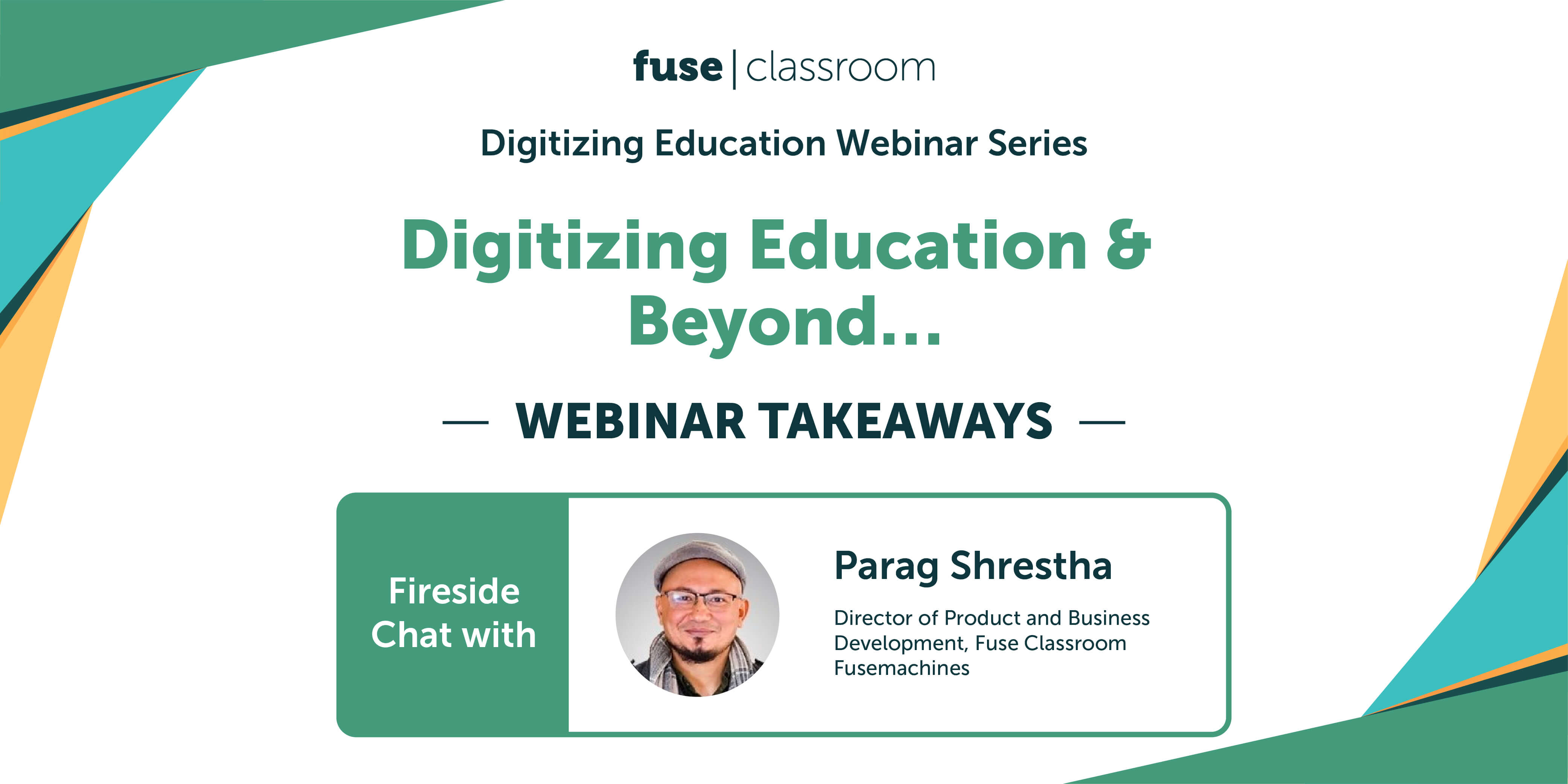On September 23rd Fusemachines held the first of many online informational webinars that highlight the process of digitized education and various components of Fuse Classroom. This webinar covered what digitizing education entails and its importance in schools in a post pandemic world. Fuseclassroom’s Director Parag Shrestha explains that digitizing education is indeed a process, transforming the way we organize and execute education.
The concept of digitizing education:
Digitization converts physical material into a digital format, such as paper assignments or school records. In digitized education, there are 2 main areas of focus: digitizing schools and digitizing the learning experience. The digitized learning experience focuses on improving academic outcomes for students through different learning methodologies and various types of content. Digitizing schools streamlines overall operations and automates administrative tasks. It consolidates all student records, transcripts, payments and any other important documents.
Webinar Q&A session:
Webinar attendees were able to engage with Parag Shrestha through a Q&A session. Go through some below:
Q: What is the first step in the digitization process?
A: The first step is to get your team together and do a need assessment. Once understanding what needs to be digitized the team can then generate a plan, timeline, and the budget to proceed. Fuse Classroom Specialists are provided to help schools create a personalized roadmap that is specific to the needs of that institution.
Q: What can we do to maintain students’ engagement in online learning?
A: Effective digitization should keep the students interests and learning experience in mind. Proper care and planning is essential in the digitization process to make the platform easy, intuitive, and fun. If the online content is interactive and communicative, students will be interested in using the platform more. For example, students can actively engage and collaborate on work using online discussion forums. It’s important to experiment with digital values and participation and ensure that students can receive help and support through the online platform.
“The needs of the student come before anything else.”
Q: How can we manage internet access in areas it may be inconsistent in?
A: Because the internet can be spotty in most regions, it’s important for primary and secondary stakeholders in the education industry to collaborate together, especially now since there is a tremendous benefit to digitizing. Understanding the benefits and the tangible need for online learning can be the driving force for collaboration of all stakeholders to aid cities or communities that have less access to the internet. We can reach out to internet companies and work together to make online education a reality for everyone. We can see this moment as a window of opportunity for great advancement in our education systems.
Q: What is the cost of digitizing schools using Fuse Classroom and is it sustainable for lower education institutions?
A: The cost of digitizing and implementing Fuse Classroom varies from school to school. The number of students and specific learning packages is taken into consideration when determining the price. Our current campaign: the Education Digitization Grant (non-cash credit) program is currently helping schools digitize and make Fuse Classroom financially feasible for them by offering the service to them for a period of time.
The Education Digitization Grant can be found here!
Q: What are the benefits of Fuse Classroom?
A: Fuse Classroom combines administrative records and data as well as all the tools to run online courses where everything is in one place. “Ultimately we have a very comprehensive holistic solution. Therefore, you don’t have to deal or switch between other applications.” Our engineers who have been working with major corporations for over 10 years have created advanced AI systems to make Fuse Classroom like no other platform. AI technology and capabilities personalize the experience to cater to the needs of each individual student.
Q: What are some of the AI features in Fuse Classroom?
A: AI Smart Features included in Fuse classroom consist of a Student Status Engine which tracks a student’s performance and gives updates on how that student is performing with a color next to their name. Depending on the color (green, yellow, or red) a student will be able to see their status and determine where they need more support to continue with the best marks they can. Furthermore, Fuse Classroom has a Recommendation Engine to provide materials if a student is struggling, and Chatbots to aid students on general questions. On top of that, AI technology helps with Proctoring Tools and Plagiarism Detection. These are only a few current tools, other technologies are still in the works and being developed.
Feedback from the attendees:
A post webinar survey was sent out after the event and showed positive feedback. Majority of the people who attended were teachers and school administrators eager to learn about the impact of online learning. One attendee expressed, “It was something very new for me that we are planning to execute ourselves. It is very good that Fuse is educating about its products, and the value of digitization and AI.” Many people are looking forward to joining in on future webinars to learn more about digitization in education, AI, and Fuse Classroom.
Stay tuned for our next webinar that will cover how to build your school’s digitization experience & how to map the online student lifecycle journey on Wednesday, November 11, 2020 from 6:15-7:30 PM (NPT).
See you there!

